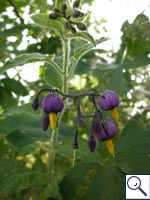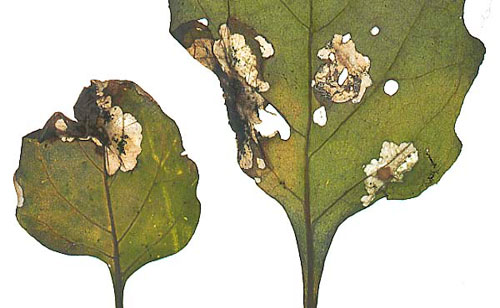|
||||||
|
SOLANUM. Bittersweet / Woody Nightshade, Nightshades and Potato. [Solanaceae] |
|
|
Twenty-eight species of Solanum are recorded in Britain. These include the native Black Nightshade (S. nigrum) and Bittersweet / Woody Nightshade (S. dulcamara) and the introduced Potato (S. tuberosum) and Aubergine (S. melongena). The BSBI provide a downloadable plant crib for the subspecies of Solanum nigrum. Lycopersicon esculentum is treated as Solanum lycopersicum by Stace (2010). Nine British miners are recorded on Solanum. The polyphagous agromyzids Liriomyza sativae and Liriomyza trifolii have been recorded in quarantine in Britain (Pitkin & Plant in British leafminers). See also Liriomyza species in Glasshouses and/or Quarantine Interceptions. A key to the European miners recorded on Solanum is provided in Bladmineerders van Europa. |
 Bittersweet / Woody Nightshade Solanum dulcamara |
Key for the identification of the known mines of British |
|
1# > Leaf-miner: Not distinguishable from the mines of P. betae or P. hyoscyami. |
|
|
|
Pegomya interruptella (Zetterstedt, 1855) [Diptera: Anthomyiidae]. |
|
1a > Leaf-miner: A distinctive mine primarily above mid-rib, with irregular short lateral offshoots into leaf blade. Pupation external (Spencer, 1972: 51 (fig. 172), 55; Spencer, 1976: 270, 271 (fig. 486)). Branched, whitish, upper-surface corridor; main axis overlying the midrib; side branches overlying the main lateral veins. (In Campanula and Phyteuma the mine is much less branched, sometimes nothing more than a corridor on top of the midrib). Frass in rather long strings. Usually the mines begins as a long and narrow, shallow, tortuous lower-surface corridor that ends upon the midrib but otherwise is not associated with the leaf venation. Often this initial corridor is filled with callus, and then even less conspicuous. Pupation outside the mine. A linear mine on the upper surface, usually following the midrib and showing side branches along the veins. The frass is in strings. |
|
|
|
Liriomyza strigata (Meigen, 1830) [Diptera: Agromyzidae]. |
|
1b > Leaf-miner: A short, irregular, linear upper surface mine on any part of the leaf. Also recorded from young pods (Bland, 1997a). Long corridor mine. As a rule the first part of the mine is lower-surface, the later part upper-surface. Often the loops are so dense that a secondary blotch is the result. Because upper- and lower-surface corridor segments often cross, the mine obtains a strange array of transparant patches. There is no association with the midrib. Frass in strings and thread fragments. Pupation outside the mine; exit slit in upper epidermis. Mine not associated with the veins or midrib of the leaf (It is this character which enables distinction from another Agromyzid pest species - Liriomyza huidobriensis). The larvae may leave one leaf (if not large enough) and enter another leaf, via the petiole). It exits the leaf to pupate through a semi-circular slit in the upper surface of the leaf. |
|
|
|
Liriomyza bryoniae (Kaltenbach, 1858) [Diptera: Agromyzidae]. |
|
1c > Leaf-miner: Blotch mine, mostly occupying almost the entire leaf, containing several larvae. |
|
|
|
Pegomya hyoscyami (Panzer, 1809) [Diptera: Anthomyiidae]. |
|
1d > Leaf-miner: Similar to the mine of Pegomya hyoscyami, but differs in the presence of an unusually large puparium. Probably a better discrimination is the unusually large clutch size, which is on averge is eleven. |
|
|
|
Pegomya dulcamarae Wood, 1913 [Diptera: Anthomyiidae]. |
|
1e > Leaf-miner: Blotch mines, generally occupying an entire leaf, usually containing several larvae. Much, half deliquescent, green frass. Mine indistinguishable from P. exilis or P. hyoscyami. |
|
|
|
Pegomya betae (Curtis, 1847) [Diptera: Anthomyiidae]. |
|
1f > Leaf-miner: The larvae forms large whitish or translucent blotches. Rather large, untidy blotch, full-depth for most of its surface, very transparent, without feeding lines and without association with midrib or leaf margin. The larva makes several mines. Often only its anterior part is inserted in the mine, that remains free of frass then (see https://bladmineerders.nl/parasites/animalia/arthropoda/insecta/lepidoptera/ditrysia/yponomeutoidea/glyphipterigidae/acrolepia/acrolepia-autumnitella/). Pupation outside the mine in a silk cocoon. |
|
|
|
Acrolepia autumnitella Curtis, 1838 [Lepidoptera: Acrolepiidae] |
|
1g > Leaf-miner: Large, glassy, irregular blotches without a recognisable preceding corridor. Frass in a black mass, mainly in the oldest part of the mine. The larvae move several times, and can also bore in the stem and underground parts. |
|
 Mine of Phthorimaea operculella on Solanum nigrum Image: © Willem Ellis (Bladmineerders van Europa) |
|
|
|
Phthorimaea operculella (Zeller, 1873) [Lepidoptera: Gelechiidae]. |
|
1h > Leaf-miner: Young larvae bore in the midrib that turns somewhat pale and translucent; from here they make rather small, brownish, wrinkled, not very transparant blotches. Later they can make blotches that extend further from the midrib, but often that rather soon take on a boring habit, or start to live freely upon the plant. Pupation external. |
|
|
|
Scrobipalpa costella (Humphreys & Westwood, 1845) [Lepidoptera: Gelechiidae]. |
|
| Last updated 30-Jul-2020 Brian Pitkin | ||
